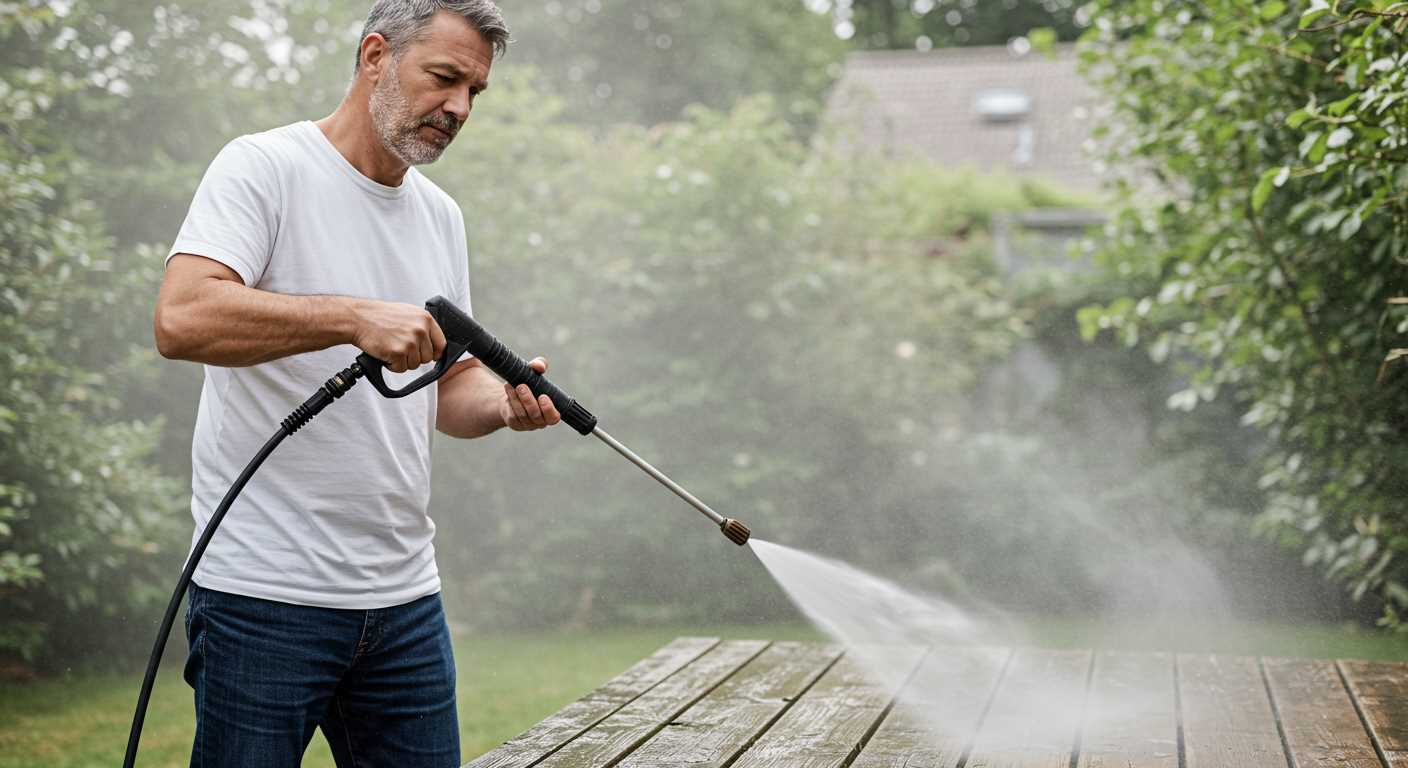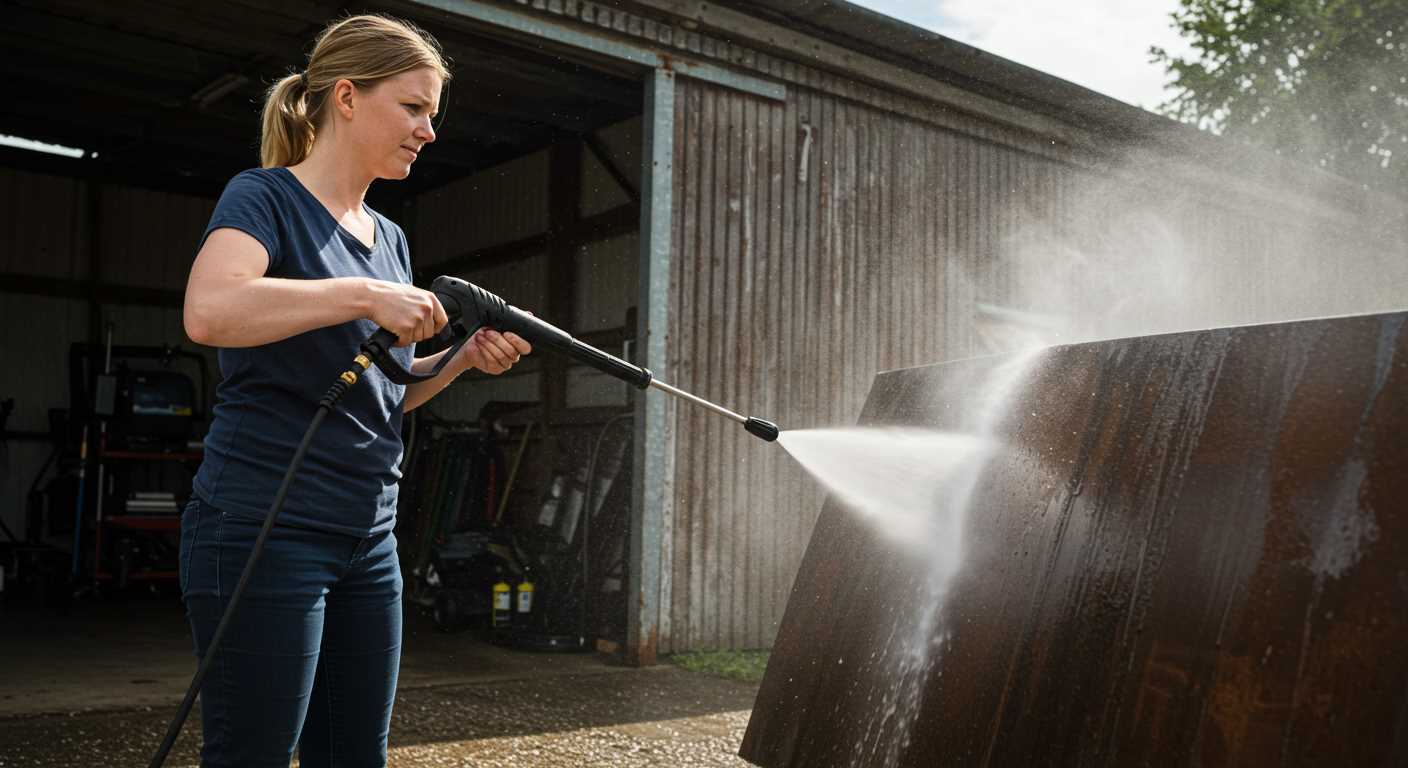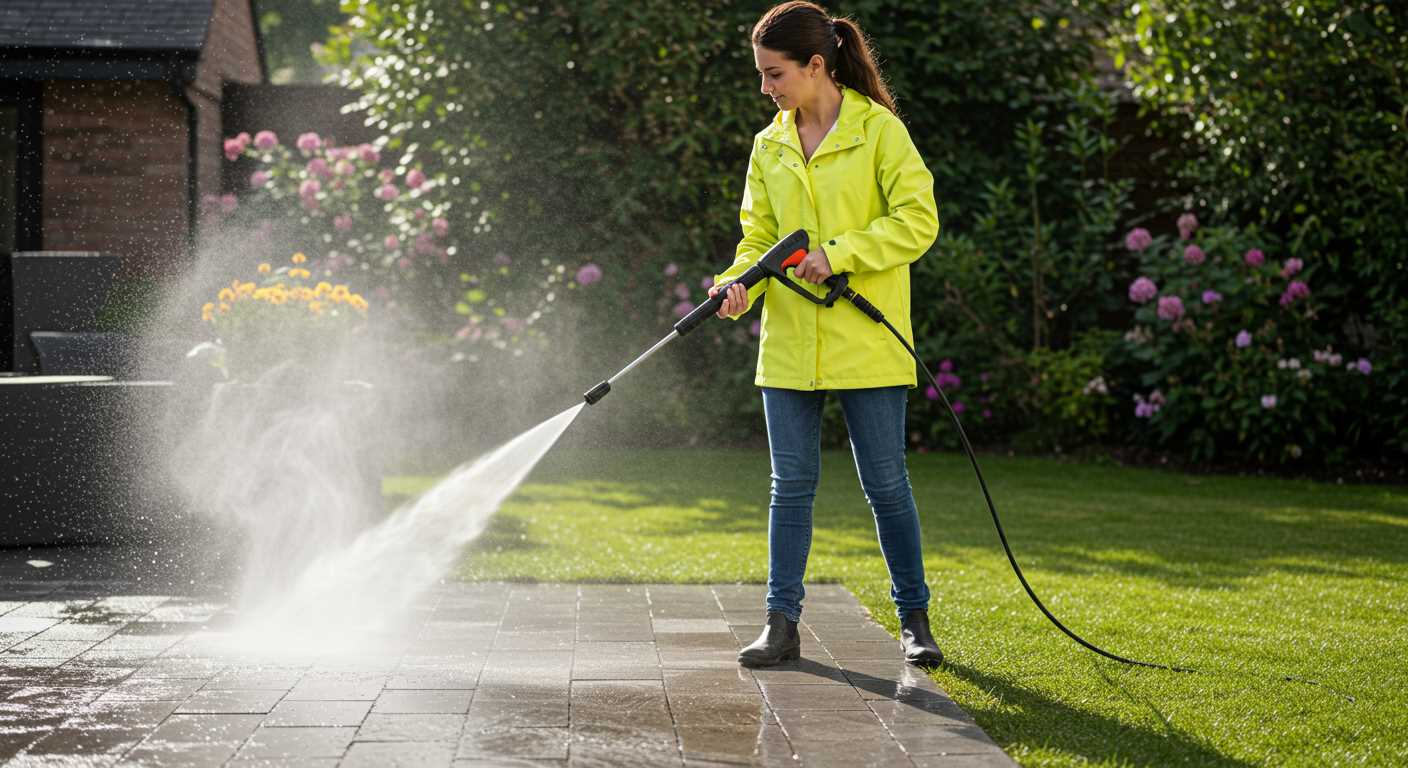



.jpg)
If your cleaning unit frequently stops running, the first step is to check the fuel supply. A low fuel level can lead to inconsistent performance. Ensure the tank is sufficiently filled with clean gasoline. Contaminated or old fuel may also cause issues, so consider draining the tank and replacing it with fresh fuel if necessary.
Another frequent culprit is the air filter. A clogged filter can restrict airflow, leading to stalling. I’ve seen many units underperform simply due to a dirty filter. Regular maintenance, including cleaning or replacing the air filter when needed, can make a significant difference in operation.
Inspect the spark plug as well. A worn or fouled plug can cause misfiring, which interrupts the engine’s operation. Replacing the spark plug at the start of each season has been a practice I adopted, and it consistently enhances reliability. If you notice any signs of wear or carbon buildup, it’s time for a change.
Pay attention to the fuel line and connections. Cracks or leaks in the fuel line can lead to air getting into the system, causing the engine to stall. A quick visual inspection can save you from larger headaches down the line. I’ve often found that a simple replacement of a faulty line resolves many intermittent operation issues.
Lastly, keep an eye on the pump. If the pump is not primed correctly or is experiencing an internal failure, it can lead to performance interruptions. Regularly checking for leaks and ensuring the pump is functioning properly can prevent unexpected shutdowns during use.
Common Issues Leading to Interruption
First, check the fuel level. An inadequate supply can cause the unit to stall unexpectedly. Always ensure there’s enough gasoline in the tank before starting your task.
Next, examine the air filter. A clogged filter restricts airflow, leading to engine shutdowns. Clean or replace the filter regularly to maintain optimal performance.
Inspect the spark plug as well. A worn or dirty spark plug can result in misfiring, causing the engine to stop. Cleaning or replacing the spark plug is a straightforward fix that can restore functionality.
Another common culprit is the carburettor. If it’s dirty or malfunctioning, it may disrupt the fuel flow. Cleaning the carburettor can often resolve this issue, ensuring a steady mix of air and fuel.
Overheating can also trigger shutdowns. Ensure the cooling system is functioning correctly, and check for blockages in the cooling fins or air intake. Regular maintenance of these areas can prevent this problem.
Lastly, look into the fuel quality. Stale or contaminated fuel can lead to performance issues. Always use fresh fuel and consider adding a fuel stabiliser if the machine will sit unused for a while.
- Check fuel level regularly.
- Maintain the air filter.
- Inspect and clean the spark plug.
- Clean the carburettor.
- Monitor for overheating.
- Use fresh, high-quality fuel.
By addressing these areas, you can significantly reduce the chances of interruptions during operation, ensuring a smoother and more reliable experience.
Identifying Fuel Supply Issues
Start by checking the fuel level in the tank. A low supply can lead to inconsistent performance. Ensure the tank is filled with fresh fuel; stale petrol can cause starting issues and stalling. I’ve seen this happen countless times during my years in the field. Customers often forget that fuel can degrade over time, especially if left unused for months.
Inspecting the Fuel Filter
Next, examine the fuel filter. A clogged filter restricts flow, causing the engine to falter. If it appears dirty or discoloured, replace it. I recall a case where a simple filter change resolved a persistent stalling issue, much to the relief of the owner.
Fuel Lines and Connections
Check the fuel lines for cracks or leaks. Damaged hoses can lead to air entering the system, disrupting the fuel delivery. Ensure all connections are tight and secure. During one service call, I found a loose connection that was allowing air to mix with the fuel, resulting in erratic engine behaviour.
Finally, consider the fuel pump’s operation. If it’s malfunctioning, it won’t provide the necessary pressure for optimal performance. Testing the pump can often pinpoint underlying issues. I’ve had customers amazed at how a small component like a fuel pump could significantly affect their equipment’s functionality.
Checking the Air Filter Condition
Inspect the air filter regularly. A clogged air filter can restrict airflow, leading to performance issues. Remove the filter and hold it up to the light; if you can’t see through it, clean or replace it. I recall a time when a simple air filter change resolved an ongoing issue for a customer, allowing their equipment to run smoothly once again.
Cleaning the Air Filter
For foam or sponge filters, wash them in warm, soapy water, then rinse thoroughly. Allow them to dry completely before reinstalling. Paper filters should be replaced if they appear dirty. I once had a client who ignored a dirty filter, and it caused the machine to stall repeatedly during use, leading to frustration. A quick filter check could have saved them time.
Replacement Recommendations
Always use the manufacturer’s recommended air filter for optimal performance. Third-party options may not fit correctly or provide adequate filtration. I’ve seen many situations where non-genuine parts led to more extensive issues down the line. Keep your equipment in top shape by sticking to the right components.
Inspecting the Spark Plug Functionality
Start by removing the spark plug for a thorough examination. Look for carbon build-up, which can indicate incomplete combustion. If you notice a thick layer of soot or oil residue, it’s time for a replacement. A clean, well-functioning spark plug should have a light brown or grey colour.
Next, check the gap between the electrodes. Use a feeler gauge to ensure the gap is within the manufacturer’s specifications, typically around 0.028 to 0.031 inches. An improper gap can lead to misfiring or difficulty in starting the engine.
Testing Spark Plug Condition
Connect the spark plug to the ignition lead and ground it against the engine block. Pull the starter cord and observe the spark. A strong, blue spark indicates good functionality, while a weak, yellow spark suggests that the plug may be faulty or worn out. If there’s no spark at all, consider replacing it.
Regular Maintenance Tips
After reinstallation, ensure the spark plug is tightened to the correct torque level, usually around 13 to 15 ft-lbs. Regularly check the spark plug every 25 hours of operation or at the start of each season. This simple maintenance task can prevent ignition problems and ensure smooth operation over time.
Examining the Water Supply and Connections
Check the water source. Ensure your unit is receiving adequate water pressure. A garden hose with kinks or blockages can restrict flow, leading to shutdowns. I once spent hours troubleshooting a similar issue, only to discover the hose was pinched behind a bush. Always inspect the entire length of the hose for any signs of damage or obstructions.
Connection Integrity
Inspect all connections. Loose fittings can result in air entering the system, causing irregular operation. I recall a client whose machine would intermittently stop due to a slightly unscrewed connection at the pump. Make sure all couplings are tight and check for leaks, as these can indicate a problem.
Water Filters and Screens
Examine any filters or screens in the water intake system. Debris buildup can hinder performance. I learned this the hard way when a client’s washer was struggling; a clogged filter was the culprit. Clean or replace filters as needed to maintain proper flow.
| Issue | Solution |
|---|---|
| Kinked Hose | Remove obstructions and straighten the hose |
| Loose Connections | Tighten fittings and inspect for leaks |
| Clogged Filter | Clean or replace filters and screens |
Understanding Overheating and Its Causes
Overheating frequently arises from insufficient coolant flow or blocked vents. Ensure that the cooling system is functioning properly; any obstruction can lead to heat buildup, causing the engine to shut down. Check the water supply connections, as inadequate water flow can lead to overheating. Inspect hoses for kinks or blockages that may inhibit proper fluid movement.
Maintenance Tips
Regular maintenance is key. Clean the water intake filter often, as debris can restrict flow. Additionally, a thorough examination of the unit’s overall condition is necessary. Pay attention to any signs of wear or damage that might affect performance. If the machine is used for extended periods, allow it to cool down periodically to prevent heat-related issues.
Other Factors to Consider
Fuel quality can also play a role in overheating. Contaminated fuel can lead to inefficient combustion, causing the engine to run hotter than normal. Always use fresh, high-quality fuel. Lastly, ensure that the air filter is clean, as a clogged filter restricts airflow, contributing to overheating. Keeping the unit in optimal condition will enhance its longevity and performance. For those interested in upkeep and cleaning tips beyond equipment, check out this how to clean leather ultimate guide for leather cleaning.
Assessing the Pressure Switch Mechanism

Start by examining the pressure switch mechanism. If it malfunctions, it can cause the motor to shut down unexpectedly. This component is responsible for regulating the pressure in the system and should activate or deactivate the motor according to the water flow. If the pressure switch is stuck or faulty, it might trigger an early shutdown.
Testing the Pressure Switch
Disconnect the pressure washer from the power source and locate the pressure switch. You’ll usually find it near the pump. Use a multimeter to check for continuity in the switch. If there’s no continuity when the switch is activated, it’s time for a replacement. A new switch is relatively inexpensive and can solve the problem quickly.
Inspecting Connections and Hoses
Next, inspect the connections and hoses linked to the pressure switch. Any leaks or blockages can affect its performance. Ensure that all connections are tight and that hoses are free from kinks or cracks. A simple visual check can save you time and frustration down the line. If you notice any damage, replace the affected parts before testing the equipment again.
Maintaining Regular Service and Repairs
Regular maintenance is non-negotiable for keeping your equipment in top shape. A consistent service schedule not only prolongs the life of your machine but also enhances its performance, ensuring it runs smoothly during your tasks.
Develop a Maintenance Schedule
- Set reminders for routine checks, ideally every 25 operating hours or as specified in the manufacturer’s manual.
- Include tasks such as oil changes, filter replacements, and inspections of vital components.
Utilise Quality Parts and Fluids
Opt for high-quality replacement parts and fluids. Cheap alternatives can lead to issues down the line. I once replaced a fuel filter with a generic one that caused more problems than it solved. Investing in reliable parts pays off.
- Use manufacturer-recommended oil types for optimal engine performance.
- Regularly replace air and fuel filters to prevent blockages.
Professional Servicing
Consider enlisting professionals for thorough servicing. They can spot potential issues that might not be visible to the untrained eye. I remember a time when a technician found a minor problem that could have escalated into a major repair if left unchecked.
For those looking at alternatives, exploring gas powered pressure washers can provide insights into more robust options that require regular upkeep as well.
Keeping a close eye on the operational health of your machine and maintaining a proactive approach to service can save you time, money, and hassle in the long run.
FAQ:
What are the common reasons for a Honda pressure washer to keep cutting off?
There are several common reasons why your Honda pressure washer might keep cutting off. One of the main issues could be related to fuel supply; if the fuel is old or contaminated, it can cause the engine to stall. Another possibility is a clogged fuel filter, which restricts the flow of fuel to the engine. Additionally, if the air filter is dirty, it can prevent the engine from receiving enough air, leading to a shutdown. Lastly, overheating due to low oil levels can also trigger the engine to cut off as a safety measure.
How can I troubleshoot my Honda pressure washer that keeps stopping unexpectedly?
To troubleshoot your Honda pressure washer, start by checking the fuel tank. Ensure that there is enough fuel and that it is fresh. Next, inspect the fuel filter and replace it if it appears clogged. Check the air filter for dirt or debris and clean or replace it as needed. Also, examine the oil level and condition; if it’s low or dirty, change it. If the problem persists, it may be wise to consult the user manual for further guidance or contact a professional for assistance.
Could a faulty spark plug be the reason my pressure washer shuts off?
Yes, a faulty spark plug can definitely cause your pressure washer to shut off. If the spark plug is worn or damaged, it may not ignite the fuel properly, leading to engine stalling. To check the spark plug, remove it and inspect it for wear or carbon build-up. If it looks damaged, replacing it can often resolve the issue. Always remember to ensure the spark plug is properly gapped according to the manufacturer’s specifications for optimal performance.
What maintenance steps can I take to prevent my Honda pressure washer from cutting off?
Regular maintenance is key to preventing your Honda pressure washer from cutting off. Start with routine checks on the fuel system; always use fresh fuel and replace the fuel filter as recommended. Clean or replace the air filter regularly to ensure proper airflow. Additionally, check the oil level frequently and change it according to the manufacturer’s schedule. Inspect the spark plug and replace it if necessary. Keeping the machine clean and in good condition will help enhance its reliability and performance.

.jpg)




.jpg)


